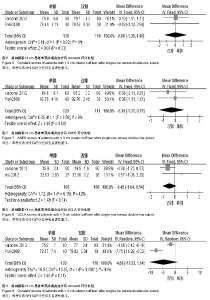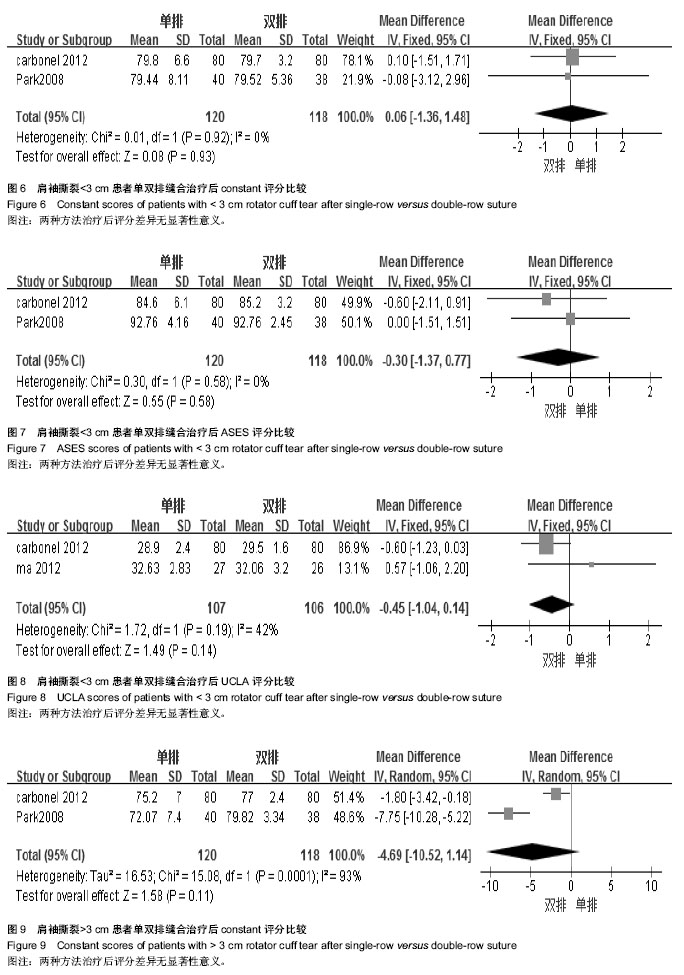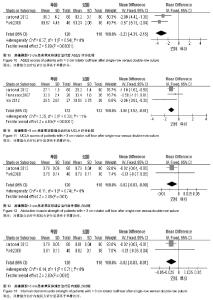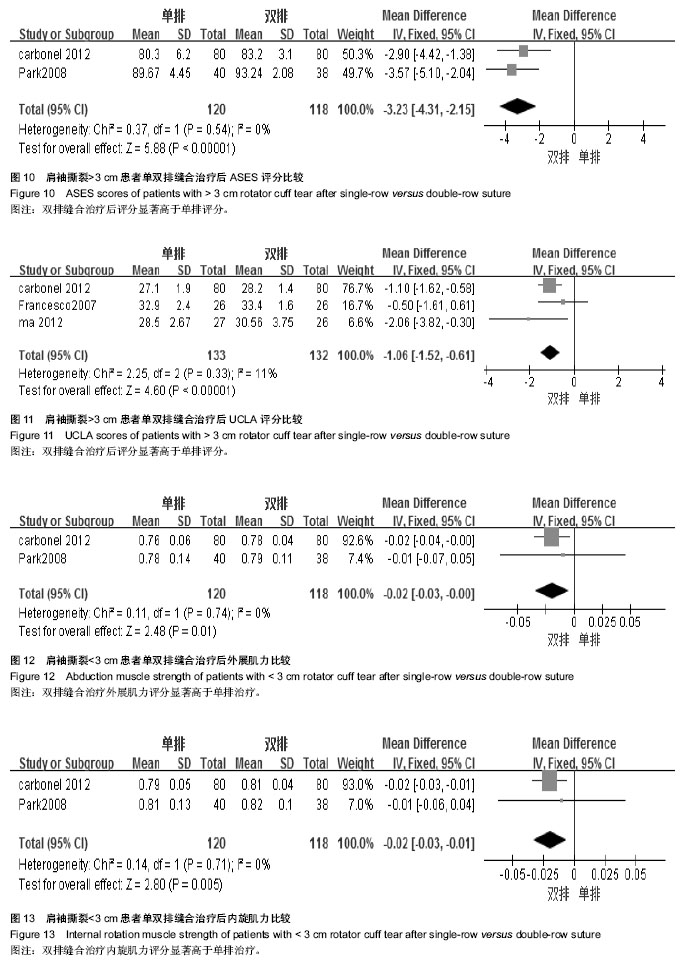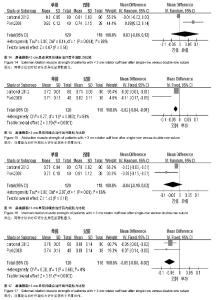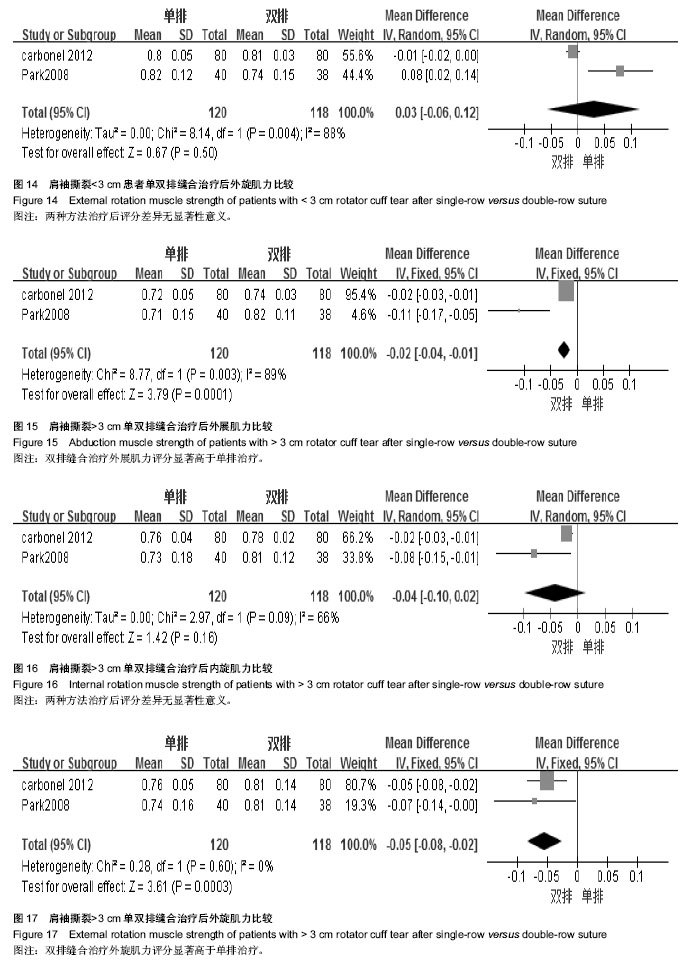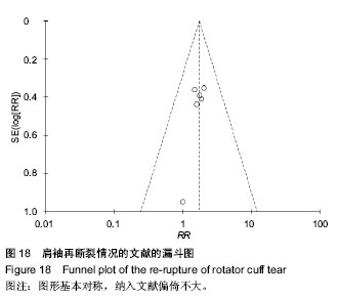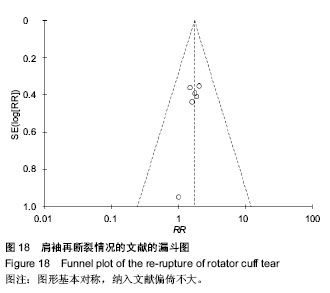Chinese Journal of Tissue Engineering Research ›› 2014, Vol. 18 ›› Issue (29): 4742-4751.doi: 10.3969/j.issn.2095-4344.2014.29.026
Previous Articles Next Articles
Single-row versus double-row suture in rotator cuff repair: a meta-analysis
Zhuang Ze, Lu Hua-ding, Chen Yu-xian, Peng You, Ren Jian-hua, Wang Kun
- Department of Joint Traumatic Surgery, Third Affiliated Hospital of Sun Yat-sen University, Guangzhou 510630, Guangdong Province, China
-
Revised:2014-05-26Online:2014-07-09Published:2014-07-09 -
Contact:Wang Kun, Chief physician, Department of Joint Traumatic Surgery, Third Affiliated Hospital of Sun Yat-sen University, Guangzhou 510630, Guangdong Province, China -
About author:Zhuang Ze, Physician, Department of Joint Traumatic Surgery, Third Affiliated Hospital of Sun Yat-sen University, Guangzhou 510630, Guangdong Province, China
CLC Number:
Cite this article
Zhuang Ze, Lu Hua-ding, Chen Yu-xian, Peng You, Ren Jian-hua, Wang Kun . Single-row versus double-row suture in rotator cuff repair: a meta-analysis[J]. Chinese Journal of Tissue Engineering Research, 2014, 18(29): 4742-4751.
share this article
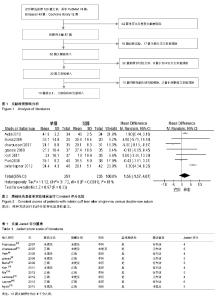
2.1 检索结果分析 按检索策略初检出文献129篇,排除了非英文和重复文献后余87篇,通过阅读标题排除动物实验和生物力学文献筛选出52篇,再阅读文章排除影像学比较,小切口与关节镜比较文献筛选出22篇,再通读全文,排除不符合纳入标准的文献,最终纳入10篇文献。发表年份2003年至2014年,随访至少12个月,研究地点均在国外。纳入10个研究中有6个随机对照研究(Level Ⅰ),4个前瞻性队列研究(Level Ⅱ),没有回顾性队列研究(Level Ⅲ),没有病例报告(Level Ⅳ)和专家意见(Level Ⅴ)。检索情况见图1。 2.2 基线分析及质量评价 对纳入文献进行改良Jadad评分。纳入10篇文献得分6分者1篇,5分者5篇,4分者4篇,得分均在4-7分之间,可视为高质量研究。文献评分情况见表1。"
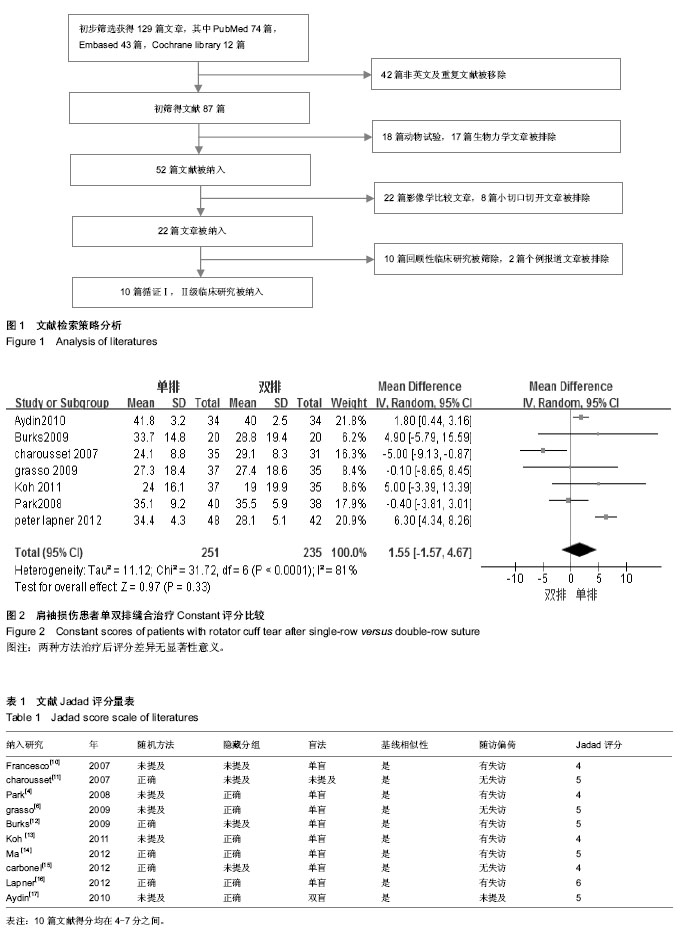
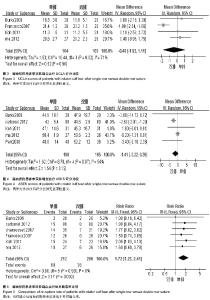
2.3 Meta分析结果 对数据进行4种分类比较:①总的肩袖损伤患者各类评分比较。②总的肩袖损伤患者外科治疗后再断裂率比较。③肩袖撕裂>3和<3 cm亚组分类的各类评分比较。④肩袖撕裂>3和<3 cm亚组分类的肩关节肌力指数(SSI)比较。 2.3.1 总的肩袖损伤患者治疗前后各类评分比较的Meta分析 10项研究在单双排组间的年龄,性别,肩袖脂肪浸润,随访时间上未见明显统计学差异,其中7个使用constant评分,4个使用AESE评分,3个使用UCLA评分进行评估。 constant评分比较结果:各研究间有统计学异质性(I2=81%),采用随机效应模型进行分析,外科治疗后单双排评分差异无显著性意义(WMD=1.55,95%CI:-1.57-4.67,P=0.33)。 UCLA评分比较:各研究间有统计学异质性(I2=71%),采用随机效应模型进行分析,外科治疗后单双排评分差异无显著性意义(WMD=-0.40,95%CI:-1.92-1.1,P=0.60)。 ASES评分比较:各研究间异质性情况有统计学异质性(I2=54%),采用随机效应模型进行分析。外科治疗后单双排评分差异无显著性意义(WMD=-1.41,95%CI:-3.22-0.39,P=0.12)。结果见图2-4。 2.3.2 各研究随访肩袖再断裂率Meta分析 10项研究中有6个报导了外科治疗后的肩袖再断裂情况,评价方法主要是采用MRI复查了解术后肩袖愈合情况。各研究间无统计学异质性(I2=0%),采用固定效应模型进行分析。结果显示外科治疗后单双排肩袖再断裂率间有显著性意义(RR=1.72,95%CI:1.23-2.41,P=0.002)。结果见图5。 2.3.3 按撕裂大小行亚组分析的Meta分析结果 肩袖撕裂<3 cm亚组的各评分比较情况:外科治疗后constant评分比较:各研究间无统计学异质性(I2=0%),采用固定效应模型进行分析,外科治疗后单双排评分差异无显著性意义(WMD=0.06,95%CI:-1.36-1.48,P=0.93)。外科治疗后ASES评分比较:各研究间无统计学异质性(I2=0%),采用固定效应模型进行分析,外科治疗后单双排评分差异无显著性意义(WMD=-0.3,95%CI:-1.37-0.77,P=0.58)。外科治疗后UCLA评分比较:各研究间无统计学异质性(I2=0%),采用固定效应模型进行分析,外科治疗后单双排评分差异无显著性意义(WMD=-0.45,95%CI:-1.04-0.14,P=0.14)。结果见图6-8。 肩袖撕裂>3 cm亚组的评分比较情况:外科治疗后constant评分比较:各研究间有统计学异质性(I2=93%),采用随机效应模型进行分析,外科治疗后单双排评分差异无显著性意义(WMD=-4.69,95%CI:-10.52-1.14,P=0.11)。外科治疗后ASES评分比较:各研究间无统计学异质性(I2=0%),采用固定效应模型进行分析,外科治疗后单双排评分差异有显著性意义(WMD=-3.23,95%CI:-4.31-2.15,P < 0.01)。外科治疗后UCLA评分比较:各研究间无统计学异质性(I2=11%),采用固定效应模型进行分析,外科治疗后单双排评分差异有显著性意义 (WMD=-1.06,95%CI:-1.52--0.61,P=0.33)。结果见图9-11。 2.3.4 肩关节肌力指数(Shoulder Strength Index,SSI) Meta分析结果 10项研究中有6个报导了外科治疗后的肩关节肌力恢复情况。评价的方法有绝对肌力的比较和相对肌力的比较,鉴于患者的个体化肩袖损伤情况不同,采用每个患者的患肩肌力对比健肩肌力的比值结果更具有参考性,作者只对采用肩关节肌力指数比较的研究进行分析。 肩袖撕裂<3 cm组:在外展肌力方面,各研究间无统计学异质性(I2=0%),采用固定效应模型进行分析,结果显示外科治疗后评分差异有显著性意义(WMD=-0.02,95%CI:-0.03-0.00,P=0.01)。在内旋肌力方面,各研究间无明显统计学异质性(I2=0%),采用固定效应模型进行分析,结果显示外科治疗后评分差异有显著性意义 (WMD=-0.02,95%CI:-0.03至-0.01,P=0.005)。在外旋肌力方面,各研究间有统计学异质性(I2=88%),采用随机效应模型进行分析,结果显示外科治疗后评分差异无显著性意义(WMD=0.03,95%CI:-0.06至-0.12,P=0.5)。结果见图12-14。 肩袖撕裂>3 cm组:在外展肌力方面,各研究间有统计学异质性(I2=89%),采用随机效应模型进行分析,结果显示外科治疗后评分差异有显著性意义(WMD=-0.02,95%CI:-0.04至-0.01,P < 0.01)。在内旋肌力方面,各研究间有统计学异质性(I2=66%),采用随机效应模型进行分析,结果显示外科治疗后评分差异无显著性意义(MD=-0.04,95%CI:-0.1-0.02,P=0.16)。在外旋肌力方面,各研究间无统计学异质性(P=0.6,I2=0%),采用固定效应模型进行分析,结果显示外科治疗后评分差异有显著性意义(WMD=-0.05,95%CI:-0.08-0.02,P < 0.01)。结果见图15-17。 综合以上情况分析,外展肌力在>3 cm组和<3 cm组结论都支持双排缝合组术后外展肌力优于单排缝合组。 2.3.5 发表偏倚情况 对进行肩袖再断裂随访的研究行漏斗图分析,以RR值为横坐标,SE(logRR)为纵坐标绘制漏斗图,所有点大部分都位于两虚线所围成的范围内,且基本对称分布于OR合并线的两侧,呈倒“漏斗状”,图形基本对称,作者认为在肩袖再断裂率的Meta研究纳入文献的发表性偏倚不大。结果见图18。"
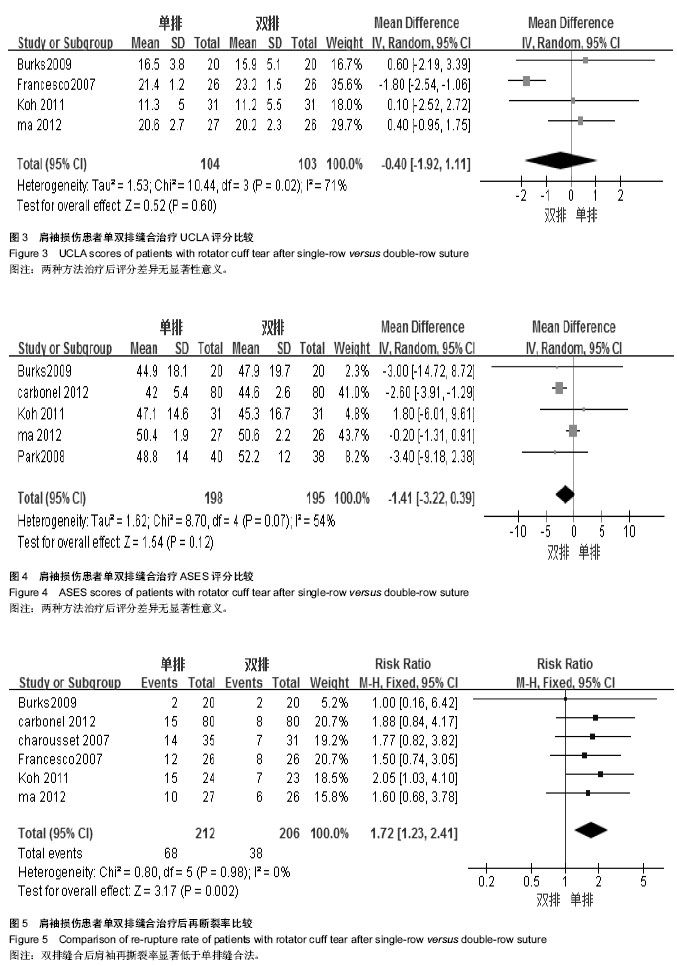
| [1] Liem D, Bartl C, Lichtenberg S, et al.Clinical outcome and tendon integrity of arthroscopic versus mini-open supraspinatus tendon repair: A magnetic resonance imaging-controlled matched-pair analysis. Arthroscopy. 2007; 23:514-521. [2] Smith CD, Alexander S, Hill AM, et al.A biomechanical comparison of single and double-row ?xation in arthroscopic rotator cuff repair.J Bone Joint Surg Am. 2006;88:2425-2431.
[3] Milano G, Grasso A, Zarelli D,et al.Comparison between single-row and double-row rotator cuff repair: A biomechanical study. Knee Surg Sports Traumatol Arthrosc.2008;16:75-80.
[4] Park JY, Lhee SH, Choi JH,et al.Comparison of the clinical outcomes of single- and double-row repairs in rotator cuff tears. Am J Sports Med.2008;36:1310-1316.
[5] Sugaya H, Maeda K, Matsuki K,et al. Functional and structural outcome after arthroscopic full-thickness rotator cuffrepair: Single-row versus dual-row ?xation. Arthroscopy. 2005;21:1307-1316.
[6] Grasso A, Milano G, Salvatore M,et al. Single-row versus double-row arthroscopic rotator cuff repair: A prospective randomized clinical study.Arthroscopy. 2009;25:4-12.
[7] Jadad AR, Moore RA, Corral D. Assessing the quality of the reports of randomized clinical trials: is blinding necessary? Control Clin Trials.1996;17(1):1-12.
[8] Constant CR, Murley AH.A clinical method of functional assessment of the shoulder. Clin Orthop Relat Res. 1987: 160-164.
[9] Michener LA,McClure PW,Sennett BJ.American Shoulder and Elbow Surgeons Standardized Shoulder Assessment Form, patient self-report section: Reliability, validity, and respon-siveness. J Shoulder Elbow Surg.2002;11:587-594.
[10] Franceschi F, Ruzzini L, Longo UG, et al. Equivalent clinical results of arthroscopic single-row and double-row suture anchor repair for rotator cuff tears: A randomized controlled trial. Am J Sports Med 2007;35:1254-1260.
[11] Charousset C, Grimberg J, Duranthon LD,et al.Can a double-row anchorage technique improve tendonhealing in arthroscopic rotator cuff repair? A prospective non randomized, comparative study of double-row and single-row anchorage techniques with computed tomographic arthrography tendon healing assessment. Am J Sports Med. 2007;35:1247-1253.
[12] Burks RT, Crim J, Brown N,et al.A prospectiver and randomized clinical trial comparing arthroscopic single-and double-row rotator cuff repair. Am J Sports Med. 2009;37:647-683.
[13] Koh KH, Kang KC, Lim TK,et al. Prospective randomized clinical trial of single- versus double-row suture anchor repair in 2-to 4-cm rotator cuff tears: clinical and magnetic resonance imaging results. Arthroscopy.2011;27:453-462.
[14] Ma HL, Chiang ER, Wu HT,et al.Clinical outcome and imaging of arthroscopic single-row and double row rotator cuff repair: a prospective randomized trial. Arthroscopy.2012;28:16-24.
[15] Carbonel I, Martinez AA, Calvo A,et al.Single-row versus double-row arthroscopic repair in the treatment of rotator cuff tears: A prospective randomized clinical study. Int Orthop. 2012; 36:1877-1883.
[16] Lapner PL, Sabri E, Rakhra K, et al. A multicenter randomized controlled trial comparing single-row with double-row ?xation in arthroscopic rotator cuff repair.J Bone Joint Surg Am. 2012;94:1249-1257.
[17] Aydin N, Kocaoglu B, Guven O. Single-row versus double-row arthroscopic rotator cuff repair in small- to medium-sized tears. J Shoulder Elbow Surg.2010;19:722-5.
[18] Kim DH,Elattrache NS,Tibone JE, et al.Biomechanical comparison of a single-row versus double-row suture anchor technique for rotator cuff repair. Am J Sports Med. 2006;34: 407-414.
[19] Meier SW, Meier JD. The effect of double-row ?xation on initial repair strength in rotator cuff repair: A biomechanical study. Arthroscopy.2006;22:1168-1173.
[20] Cummins CA, Murrell GA.Mode of failure for rotator cuff repair with suture anchors identi?ed at revision surgery.J Shoulder Elbow Surg.2003;12:128-133.
[21] Wall LB, Keener JD, Brophy RH, et al.Systematic Review Clinical Outcomes of Double-Row Versus Single-Row Rotator Cuff Repairs.Arthroscopy.2009;25(11):1312-1318.
[22] Perser K,Godfrey D,Bisson L.Meta-analysis of Clinical and Radiographic Outcomes After Arthroscopic Single-Row Versus Double-Row Rotator Cuff Repair. Sports Health. 2011; 3(3):268-274
[23] DeHaan AM,Axelrad TW,Kaye E, et al. Does Double-Row Rotator Cuff Repair Improve Functional Outcome of Patients Compared With Single-Row Technique? Am J Sports Med. 2012;40(5):1176-1185.
[24] Bishop J, Klepps S, Lo IK, et al.Cuff integrity after arthroscopic versus open rotator cuff repair: A prospective study.J Shoulder Elbow Surg.2006;15:290-299.
[25] Nho SJ, Brown BS, Lyman S, et al. Prospective analysis of arthroscopic rotatorcuff repair: Prognostic factors affecting clinical and ultrasound outcome. J Shoulder Elbow Surg. 2009;18:13-20. |
| [1] | Chen Ziyang, Pu Rui, Deng Shuang, Yuan Lingyan. Regulatory effect of exosomes on exercise-mediated insulin resistance diseases [J]. Chinese Journal of Tissue Engineering Research, 2021, 25(25): 4089-4094. |
| [2] | Chen Yang, Huang Denggao, Gao Yuanhui, Wang Shunlan, Cao Hui, Zheng Linlin, He Haowei, Luo Siqin, Xiao Jingchuan, Zhang Yingai, Zhang Shufang. Low-intensity pulsed ultrasound promotes the proliferation and adhesion of human adipose-derived mesenchymal stem cells [J]. Chinese Journal of Tissue Engineering Research, 2021, 25(25): 3949-3955. |
| [3] | Yang Junhui, Luo Jinli, Yuan Xiaoping. Effects of human growth hormone on proliferation and osteogenic differentiation of human periodontal ligament stem cells [J]. Chinese Journal of Tissue Engineering Research, 2021, 25(25): 3956-3961. |
| [4] | Sun Jianwei, Yang Xinming, Zhang Ying. Effect of montelukast combined with bone marrow mesenchymal stem cell transplantation on spinal cord injury in rat models [J]. Chinese Journal of Tissue Engineering Research, 2021, 25(25): 3962-3969. |
| [5] | Gao Shan, Huang Dongjing, Hong Haiman, Jia Jingqiao, Meng Fei. Comparison on the curative effect of human placenta-derived mesenchymal stem cells and induced islet-like cells in gestational diabetes mellitus rats [J]. Chinese Journal of Tissue Engineering Research, 2021, 25(25): 3981-3987. |
| [6] | Hao Xiaona, Zhang Yingjie, Li Yuyun, Xu Tao. Bone marrow mesenchymal stem cells overexpressing prolyl oligopeptidase on the repair of liver fibrosis in rat models [J]. Chinese Journal of Tissue Engineering Research, 2021, 25(25): 3988-3993. |
| [7] | Liu Jianyou, Jia Zhongwei, Niu Jiawei, Cao Xinjie, Zhang Dong, Wei Jie. A new method for measuring the anteversion angle of the femoral neck by constructing the three-dimensional digital model of the femur [J]. Chinese Journal of Tissue Engineering Research, 2021, 25(24): 3779-3783. |
| [8] | Meng Lingjie, Qian Hui, Sheng Xiaolei, Lu Jianfeng, Huang Jianping, Qi Liangang, Liu Zongbao. Application of three-dimensional printing technology combined with bone cement in minimally invasive treatment of the collapsed Sanders III type of calcaneal fractures [J]. Chinese Journal of Tissue Engineering Research, 2021, 25(24): 3784-3789. |
| [9] | Qian Xuankun, Huang Hefei, Wu Chengcong, Liu Keting, Ou Hua, Zhang Jinpeng, Ren Jing, Wan Jianshan. Computer-assisted navigation combined with minimally invasive transforaminal lumbar interbody fusion for lumbar spondylolisthesis [J]. Chinese Journal of Tissue Engineering Research, 2021, 25(24): 3790-3795. |
| [10] | Hu Jing, Xiang Yang, Ye Chuan, Han Ziji. Three-dimensional printing assisted screw placement and freehand pedicle screw fixation in the treatment of thoracolumbar fractures: 1-year follow-up [J]. Chinese Journal of Tissue Engineering Research, 2021, 25(24): 3804-3809. |
| [11] | Shu Qihang, Liao Yijia, Xue Jingbo, Yan Yiguo, Wang Cheng. Three-dimensional finite element analysis of a new three-dimensional printed porous fusion cage for cervical vertebra [J]. Chinese Journal of Tissue Engineering Research, 2021, 25(24): 3810-3815. |
| [12] | Wang Yihan, Li Yang, Zhang Ling, Zhang Rui, Xu Ruida, Han Xiaofeng, Cheng Guangqi, Wang Weil. Application of three-dimensional visualization technology for digital orthopedics in the reduction and fixation of intertrochanteric fracture [J]. Chinese Journal of Tissue Engineering Research, 2021, 25(24): 3816-3820. |
| [13] | Sun Maji, Wang Qiuan, Zhang Xingchen, Guo Chong, Yuan Feng, Guo Kaijin. Development and biomechanical analysis of a new anterior cervical pedicle screw fixation system [J]. Chinese Journal of Tissue Engineering Research, 2021, 25(24): 3821-3825. |
| [14] | Lin Wang, Wang Yingying, Guo Weizhong, Yuan Cuihua, Xu Shenggui, Zhang Shenshen, Lin Chengshou. Adopting expanded lateral approach to enhance the mechanical stability and knee function for treating posterolateral column fracture of tibial plateau [J]. Chinese Journal of Tissue Engineering Research, 2021, 25(24): 3826-3827. |
| [15] | Zhu Yun, Chen Yu, Qiu Hao, Liu Dun, Jin Guorong, Chen Shimou, Weng Zheng. Finite element analysis for treatment of osteoporotic femoral fracture with far cortical locking screw [J]. Chinese Journal of Tissue Engineering Research, 2021, 25(24): 3832-3837. |
| Viewed | ||||||
|
Full text |
|
|||||
|
Abstract |
|
|||||
